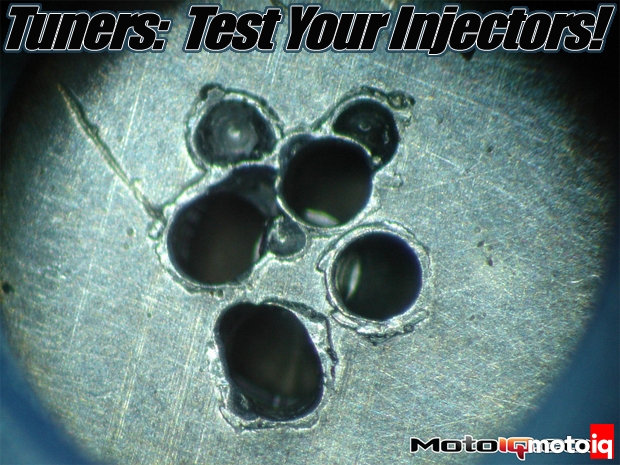
Oh my God, what a mess this has become! As race engine development moves forward, aftermarket fuel injectors seem to be moving sideways. About ten years back a trend started to modify stock injectors for higher flow rates. This was done by either drilling out the spray orifices or removing the spray plate all together! While some of the companies attempting this seemed to be making a serious effort, actual flow testing in many cases would indicate otherwise. No doubt someone will eventually figure out how to do this accurately, but in the mean time, they at least need to be willing to do actual flow testing, static and dynamic on each injector (no duplicated flow sheets please). Add this twist to the already diverse methods used to state injector flow values and you have a bit of a mess to sort out.



Above, are various OEM manufacturers new multi-hole injectors. Spray patterns are well defined and flow rates are consistent and predictable over a wide range of pressures and pulse widths.
If you are a tuner, nothing can be more frustrating then turning out an otherwise perfect race engine, only to have it burned down by a set of crudely modified injectors! On the other hand, it is the tuner’s responsibility to know, not assume, that injectors, MAF/MAP sensors, fuel pressure, etc. are beyond question before starting a tuning process. So, what to do?? If you tune professionally and have or are building a reputation as such, you must flow test every injector yourself or at least audit any flow reports you will be relying on. Very simply said, it’s your reputation at stake. Once you get into the habit of flow testing each set of injectors, you will find the good, bad and the ugly out there. Why would you build a perfectly balanced and blueprinted engine at great expense, only to subject it to an unqualified set of injectors?



More OEM injectors, clean and precise micro machining of the spray plate for accurate flow and spay patterns using high tech machining methods. Some of the holes are even vectored for better atomization.
So, how to do this testing as simply and accurately as possible? First, get yourself a copy of SAE J1832 for details on test rigs, best practices and testing. Also, pick up a copy of J2715 for quantifying spray patterns; both will give you the references to quantify your own test process. As to which fluid you use, there are 4 to choose from, Gasoline, N-Heptane, 40CFR86, or Mineral Spirits. Ok, Gasoline might seems like a winner here, but unless you’re suicidal, don’t do it! N-Heptane (also very flammable) and 40CFR86 are considered the better reference fluids, but may be harder to obtain in fresh lab quality for every day testing, however a gallon or so of N-Heptane should be obtained for comparative testing.



